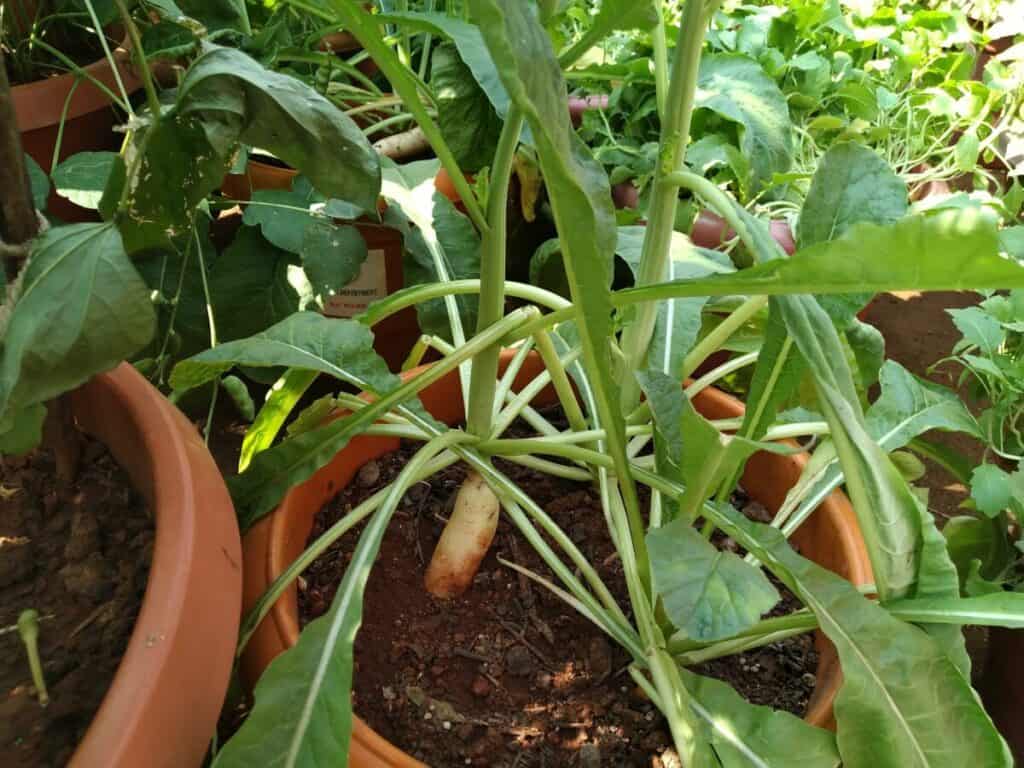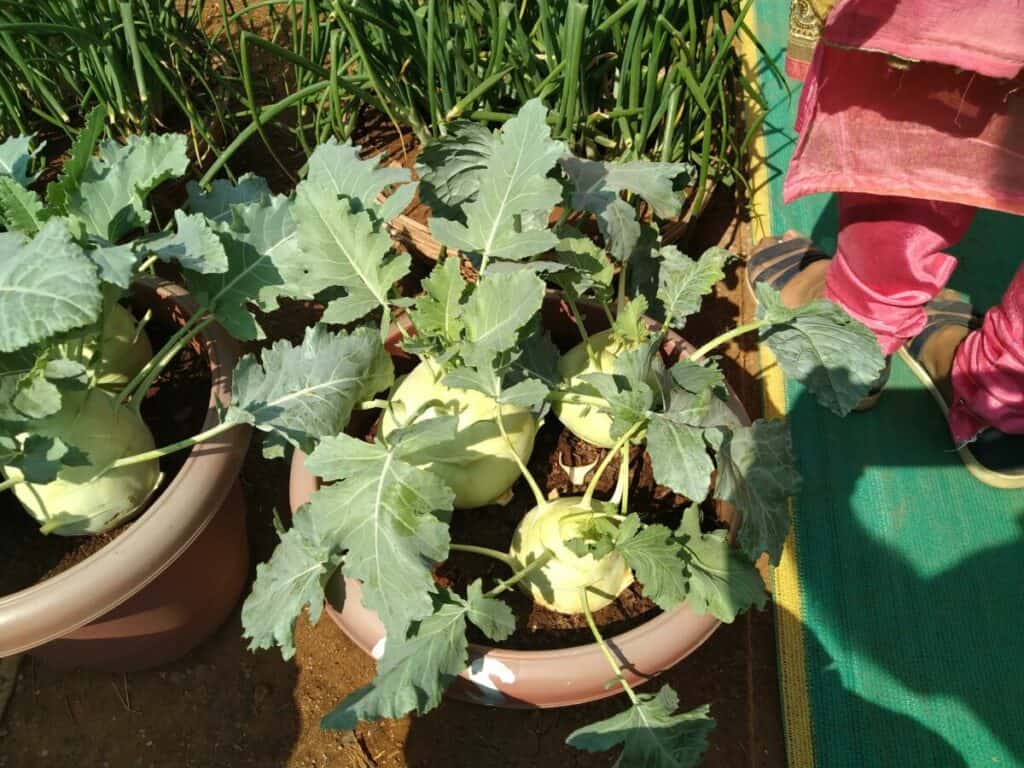I wanted to grow some root vegetables in my container garden and decided to research what is available. This post contains my list of the 22 best root vegetables you can grow in containers.
Best root vegetables to grow in containers are radish, carrot, onion, beet, potatotes, sweet potatoes, parsnip, garlic, turnip, ginger, yam, turmeric.
| Vegetable | Container Depth | Sunlight | Water | Maturity |
| Parsnip | 24 inches | 6 hours per day | When 1-inch soil is dry | 95 to 120 days |
| Rutabaga | 12 inches | 6 hours per day | When 1-inch soil is dry | 80 to 120 days |
| Turmeric | 12 inches | 4 hours per day | When 1-inch soil is dry | 8 to 10 months |
| Fennel | 10 inches | 6 hours per day | When 1-inch soil is dry | 60 to 70 days |
| Cassava | 18 inches | 6 hours per day | When 1-inch soil is dry | 6 to 7 months |
| Onion | 10 inches | 10 hours per day | When 1-inch soil is dry | 100 to 175 days |
| Garlic | 18 inches | 6 hours per day | When 1-inch soil is dry | 8 to 9 months |
| Turnip | 12 inches | 6 hours per day | When 1-inch soil is dry | 30 to 60 days |
| Horseradish | 24 inches | 6 hours per day | When 1-inch soil is dry | 12 months |
| Sweet potato | 18 inches | 6 hours per day | When 1-inch soil is dry | 90 to 170 days |
| Taro | 6 inches | 6 hours per day | When 1-inch soil is dry | 6 to 12 months |
| Potato | 15 inches | 6 hours per day | When 1-inch soil is dry | 70 to 90 days |
| Carrot | 12 inches | 6 hours per day | When 1-inch soil is dry | 50 to 60 days |
| Beet | 12 inches | 6 hours per day | When 1-inch soil is dry | 55 to 70 days |
| Ginger | 12 inches | 5 hours per day | When 1-inch soil is dry | 10 to 12 months |
| Radish | 12 inches | 6 hours per day | When 1-inch soil is dry | 22 to 70 days |
| Yam | 18 inches | 6 hours per day | When 1-inch soil is dry | 8 to 11 months |
| Celeriac | 8 inches | 6 hours per day | When soil surface is dry | 120 days |
| Crosne | 12 inches | 6 hours per day | When 1-inch soil is dry | 5 to 7 months |
| Kohlrabi | 16 inches | 6 hours per day | When 1-inch soil is dry | 45 to 60 days |
| Jerusalem artichoke | 12 inches | 6 hours per day | When 1-inch soil is dry | 130 days |
| Parsley root | 18 inches | 6 hours per day | When 1-inch soil is dry | 70 to 90 days |
1. Parsnip
A parsnip is a root vegetable that belongs to the carrot and parsley family. It has cream-colored skin and white flesh. You can eat them raw but they taste better when roasted, fried, boiled, or steamed.
2. Rutabaga
This is also known as Swedish turnip and has a mild, bitter flavor when raw. If you cook them they become more savory and sweet. You can eat these raw, boiled, steamed, or fried.
They make a great addition to soups, you can add them to a salad, or boil them to eat as a side dish with meat.
3. Turmeric
Turmeric is a flowering plant that belongs to the ginger family. It originates in Southeast Asia where it’s used as a spice and medicine. Turmeric spice adds a yellow color to food and gives it a peppery, earthy, and aromatic flavor.
4. Fennel
Fennel is a flowering plant that belongs to the carrot family. The leaves, stalk, and bulb of the plant are edible. The bulb gives an aromatic, licorice flavor to your dish. You can eat it raw, boiled, or steamed. You can add it to your soups and side dishes.
5. Cassava
Cassava is a starchy, tuberous root that is widely used in South America. It has brown skin and white flesh. It’s poisonous when raw so you need to cook it well before you eat it. It is eaten mashed, added in stews, or made into bread or chips.
6. Onion
Onions are a bulb related to the garlic, shallot, and leek family. They have a pungent flavor which makes them good to add to meat and egg dishes. When you cook them, the onions caramelize and turn sweet. You can add them to baked food or cook them with other vegetables for a side dish.
7. Garlic
Garlic is a plant that belongs to the onion, leek, shallot family, and is native to Central Asia and Iran. It has been used as a seasoning for several thousand years. You can use it as a flavoring in salad dressings, marinades, sauces, vegetables, and meats.
8. Turnip
Turnips are a root vegetable that is related to radishes and arugula. They are a fleshy taproot with white flesh. You can eat them raw in a salad or cook them up as a side dish for meat, chicken, or fish.
9. Horseradish
Horseradish is a root vegetable that is native to Europe and Asia. It’s commonly used as a spice or condiment. You can use it fresh or as part of a sauce for your meat dishes. You can add it to potato salad or mayonnaise.
10. Sweet potato
The sweet potato is a root vegetable that belongs to the morning glory family. It’s not actually a potato tuber but a starchy, fibrous, root. You can eat them raw or roasted as part of a salad. They have a sweet flavor so you can eat them as a snack when boiled, roasted, or fried.
11. Taro
Taro is the root of the taro plant that originates in Southeast Asia. It is a starchy root that has brown outer skin and white flesh. The flavor is slightly sweet and nutty. It’s not good to eat taro raw as it can irritate the throat. You need to boil, steam, or bake it to use as a side dish.
12. Potato
Potatoes are a starchy tuber that is native to America. They are thought of as root vegetables though they are a tuber that provides food to the leafy part of the plant.
Potatoes are a popular food everywhere in the world. You can eat them baked, fried, roasted, or mashed. They make a great accompaniment to meat dishes. Or you can eat them as a snack like chips or fries.
13. Carrot
The carrot is a domesticated root vegetable that is red, orange, purple, white, or yellow in color. They originated in Persia and were used for leaves and seeds.
You can eat carrots raw in your salad. Or you can cook them up in soups and stews. They taste great steamed, boiled, or roasted.
14. Beet
Beets are a taproot that are red in color and you can consume the leaves and root of the plant. You can add raw sliced beets in your salad. Or you can steam, boil, or roast them as a side dish.
15. Ginger
This is a flowering plant that is related to turmeric and cardamom. It’s a native of Southeast Asia and is widely used as a spice and medicine.
Ginger works great as a spice in fish and meat dishes. It is widely used as part of stir-fry dishes in Asia. You can also add a little bit to spice up your tea.
16. Radish

Radish is a domesticated root vegetable that originated in Asia. You can get it in several colors like red, white, or purple. They have a pungent flavor and you can eat them raw in your salad. You can also pickle them, roast or cook them, or add them to a soup.
17. Yam
Yam is an edible starchy tuber that is commonly used in Africa, South America, Asia, and the Caribbean. They look similar to a sweet potato but they are less sweet, more starchy, and dry.
It’s best to use yam after cooking them. They work great as a side dish when boiled or baked. You can add them to stews, soups, and braises. You can eat them mashed or added to bread.
18. Celeriac
This is also known as celery root and is a variety of celery. It has an edible stem and roots you can use in cooking. It tastes similar to a potato having an earthy taste with a hint of celery flavor.
The best way to cook celeriac is to boil or bake it and mash it up with other root vegetables. You can also roast it or add it to the soup.
19. Crosne
Crosne is also known as Chinese Artichoke. It is a root vegetable that originated in China. It has a sweet, nutty flavor and you can eat it raw, cooked, or dried. You can use them in a salad, stir-fry, and pickles. It’s best not to cook them too much as they get mushy.
20. Kohlrabi

Kohlrabi is also known as German turnip and belongs to the same family as cabbage and broccoli. It has long, green leaves and you can eat all parts of the plant. Kohlrabi tastes the best when added to a salad mix. You can also roast, grill, or boil it as a side dish.
21. Jerusalem artichoke
This is also known as a sunchoke and belongs to the sunflower family. It is a native plant of North America and is used as a root vegetable. You can eat them raw when mixed in a salad. You can even steam, boil, or microwave them and they become soft like potatoes.
22. Parsley root
This is the root of the parsley herb and is white in color. It belongs to the carrot family and is used in European cuisine. You can eat it steamed, boiled, or creamed and it makes a good addition to soups, stews, and braises.

Fact Checked, Written, and Published by Kevin Rodrigues
Kevin is the founder of Gardening Mentor, a website that aims to teach people to grow their own food in a limited space. As a self-taught gardener, Kevin has spent several years growing plants and creating gardening content on the website. He is certified in Home Horticulture and Organic Gardening from Oregon State University. He has a Post Graduate Diploma in Horticulture and Landscape Gardening from Mumbai University.
Read more
